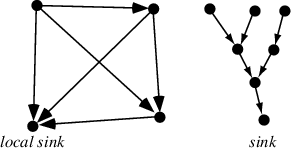Why “sink?”
25 Apr 2020 ⇐ Notes archive(This is an entry in my technical notebook. There will likely be typos, mistakes, or wider logical leaps — the intent here is to “let others look over my shoulder while I figure things out.”)
“Sink” is a word you’ll see all over reactive declarative programming, and Combine is no exception.
There’s Subscribers.Sink (the subscriber behind the two Publisher.sink overloads), CombineExt.Sink (albeit internally-scoped), and similarly in the framework’s predecessor, RxSwift.Sink.
The often-cited kitchen sink metaphor aside, the term’s etymology is a bit unclear. My guess would be it borrows from the corresponding graph theory term.
A local sink is a node of a directed graph with no exiting edges, also called a terminal.

We can view a subscription graph as a directed graph between upstream publishers, through various operators, and down towards local sinks (which, in Combine’s language are Subscribers).